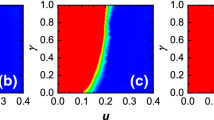Abstract
In the paper, cooperative repeated network games containing network formation stages are studied. After the first network formation stage, a particular player with a given probability may stop influencing other players by removing all her links and receiving zero payoffs. This effect is called “shock.” The effect of shock may appear only once, and the stage number, at which shock appears, is chosen at random. In the cooperative scenario of the game, subgame consistency of the Shapley value, based on a characteristic function, which is constructed in a special way, is investigated. To prevent players from breaking the cooperative agreement, a mechanism of stage payments—so-called imputation distribution procedure—is designed.




Similar content being viewed by others
Notes
Henceforth, to avoid confusion and simplify understanding, we will not add network formation stages to the number of stages in the game, whereas we will enumerate other stages from 1 to \(\ell \). The game will be considered as an \(\ell \)-stage dynamic game with at most two network formation stages.
It means that starting this moment, all links involving player m are eliminated from the network. However, player m still belongs to set N, but receives zero stage payoffs.
Behavior \((0,{\bar{{\bar{u}}}}_m)\) of player m, who leaves the game after shock, prescribes her to choose control \({\bar{{\bar{u}}}}_m\). However, according to (9), her payoff will be equal to 0 afterward for any of her controls \({\bar{{\bar{u}}}}_m \in U_m\).
References
Bala V, Goyal S (2000) A non-cooperative model of network formation. Econometrica 68(5):1181–1231
Corbae D, Duffy J (2008) Experiments with network formation. Games Econ Behav 64:81–120
Dutta B, Van den Nouweland A, Tijs S (1998) Link formation in cooperative situations. Int J Game Theory 27:245–256
Feri F (2007) Stochastic stability in networks with decay. J Econ Theory 135:442–457
Galeotti A, Goyal S, Kamphorst J (2006) Network formation with heterogeneous players. Games Econ Behav 54:353–372
Goyal S, Vega-Redondo F (2005) Network formation and social coordination. Games Econ Behav 50:178–207
Haller H (2012) Network extension. Math Soc Sci 64:166–172
Jackson M (2008) Social and economic networks. Princeton University Press, Princeton
Jackson M, Watts A (2002) On the formation of interaction networks in social coordination games. Games Econ Behav 41(2):265–291
Kuhn HW (1953) Extensive games and the problem of information. In: Kuhn HW, Tucker AW (eds) Contributions to the theory of games II. Princeton University Press, Princeton, pp 193–216
Petrosjan LA (2006) Cooperative stochastic games. In: Haurie A, Muto S, Petrosjan LA, Raghavan TES (eds) Advances in dynamic games applications to economics, management science, engineering, and environmental management series: annals of the international society of dynamic games. Basel, Birkhäuser, pp 52–59
Petrosyan LA (1977) Stability of solutions in differential games with many participants. Vestnik Leningradskogo Universiteta. Ser 1. Mat Mekhanika Astron 19:46–52
Petrosyan LA, Sedakov AA, Bochkarev AO (2013) Two-stage network games. Mat Teoriya Igr I Ee Prilozheniya 5(4):84–104
Petrosyan LA, Danilov NN (1979) Stability of solutions in non-zero sum differential games with transferable payoffs. Vestnik Leningradskogo Universiteta. Ser 1. Mat Mekhanika Astron 1:52–59
Shapley LS (1953) A value for \(N\)-person games. In: Kuhn HW, Tucker AW (eds) Contributions to the theory of games II. Princeton University Press, Princeton, pp 307–317
Vega-Redondo F (2007) Complex social networks. Cambridge University Press, New York
Watts A (2001) A dynamic model of network formation. Games Econ Behav 34:331–341
Xie F, Cui W, Lin J (2013) Prisoners dilemma game on adaptive networks under limited foresight. Complexity 18:38–47
Acknowledgments
We thank three anonymous referees for their comments that have helped in the improvement of the paper. We also thank the audience of the 20th Conference of the International Federation of Operational Research Societies for helpful discussion and suggestions.
Author information
Authors and Affiliations
Corresponding author
Additional information
The reported study was supported by the Russian Foundation for Basic Research (Projects 13-01-91160, 14-01-31141) and Saint Petersburg State University (Project 9.38.245.2014).
Rights and permissions
About this article
Cite this article
Petrosyan, L., Sedakov, A. The Subgame-Consistent Shapley Value for Dynamic Network Games with Shock. Dyn Games Appl 6, 520–537 (2016). https://doi.org/10.1007/s13235-015-0166-y
Published:
Issue Date:
DOI: https://doi.org/10.1007/s13235-015-0166-y




